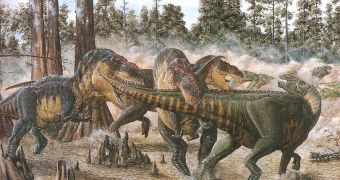The last dinosaur died 65 million years ago. So, after so much time, all you expect to find are mineralized fossils of them, in other words just bones and teeth, as flesh rapidly rots.
So you can imagine the surprise of the paleontologists when they found soft tissue in a 70 million-year-old fossil of Tyrannosaurus rex. It was a first and this started the debate whether the dinosaur DNA could be retrieved just like in the "Jurassic Park" story or not.
Paleontologists are still amazed to encounter material that seems to be dinosaur cartilage, blood vessels, blood cells and bone cells, in many different dinosaur fossils.
"It's very scary, I guess, to find this stuff so widely distributed when nobody has ever seen it before," said North Carolina State University's Mary Schweitzer, a pioneer in the field.
Ray Rogers and Kristi Curry Rogers, a husband-and-wife, geologist-and-paleontologist team at Macalester College, sent to Schweitzer fossils they had found in Madagascar.
70 million years ago, a killing drought was followed by torrential rainfall and waves of mud and wet sand covered up dead and dying dinosaurs.
"You can imagine it's like a milkshake rolling down the mountain," said Kristi Rogers.
Such rapid-preserved fossils can offer many clues.
"What Mary found was exactly the same stuff that she found in the T. rex," said Rogers, whose work focuses on long-necked dinos known as titanosaurs.
A spectacular finding was a hadrosaur specimen discovered by Schweitzer's team in 2006 in Montana's Judith River Formation.
"What we're finding is absolutely incredible, amazing preservation. It's the 'freshest,' if you will, dinosaur bone that has ever had this analysis conducted on it." said Schweitzer.
"The fossil was excavated specifically for the purposes of demineralizing and analyzing its insides. Once a fossil's interior is exposed to the air, it degrades very quickly. In fact, the T. rex fossil that started it all is becoming less and less useful for soft-tissue research with the passage of time," she said.
Dinosaurs' hot spots will explain many biochemical mysteries of the dinosaurs.
"We're getting specimens that have been collected specifically to do these kinds of tests, and that has never happened before," she said.
In 2006, a team obtained the first chemical results for T. rex collagen, a skin protein, that revealed that birds are the closest living relatives of dinosaurs. That was the start of paleobiochemistry. As far as recovering DNA dinosaur is concerned, researchers say they are not prepared to deal with it, even if fragments of dinosaur DNA could be available in the future.
"You'd need a Class 3 or Class 4 or Class 5 lab, which is the same lab you'd be working with for hantavirus or Ebola," she said.

 14 DAY TRIAL //
14 DAY TRIAL //